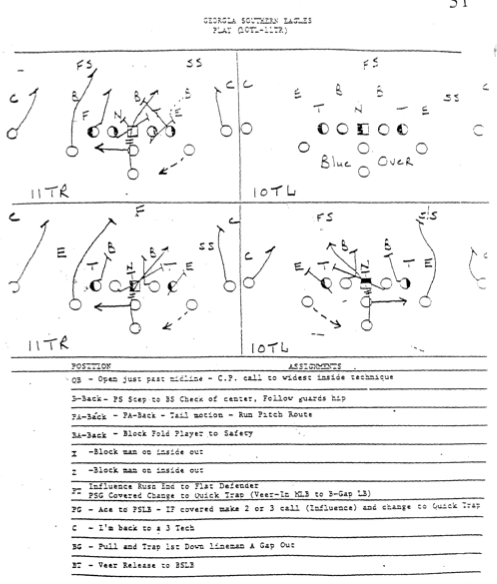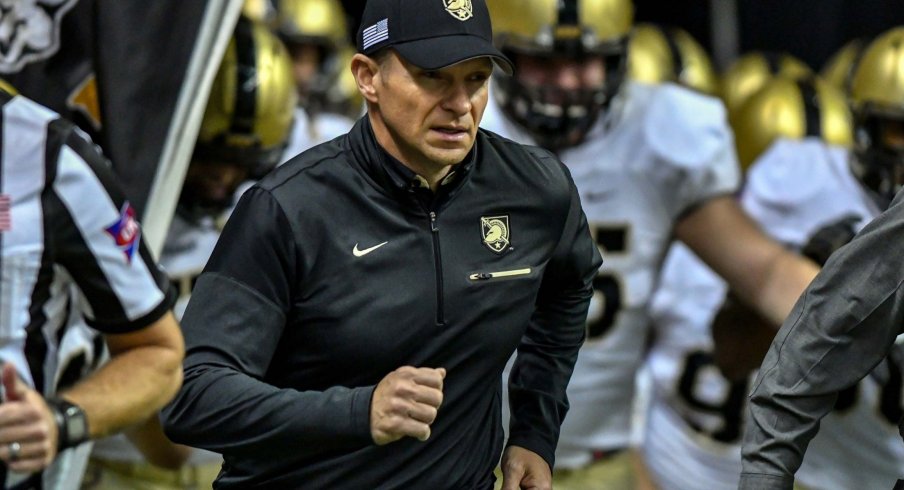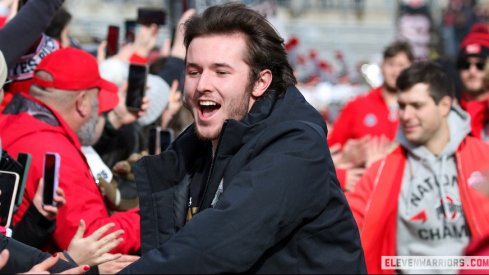While Jeff Monken's flexbone offense is undoubtedly a direct descendent of the system created by his mentor, Paul Johnson, the head coach at West Point has made certain changes of his own since leaving the Georgia Tech coach's side to lead a program of his own nearly eight years ago. Though the Illinois native's career has been defined by his relationship with Johnson to this point, Monken's philosophies aren't identical to those of his former boss.
Monken comes from a coaching family, with an equally successful cousin, Todd, currently calling plays for the Tampa Bay Buccaneers, and when examining the tape of last year's Army squad, it's clear that his offense is more than just the triple option for which it's known. While Johnson's philosophy is rooted in the idea of dictating the defense's plans with the use of balanced formations derived from the run-and-shoot, lining up one wide receiver and one 'A' (slot) back on each side, Monken has leaned heavily on the use of unbalanced lines and heavy personnel.
With defenses expecting a balanced formation from the offense with an equal number of running lanes on either side, Monken's unit regularly adds an extra tackle to the equation, creating five holes that must be filled by the four defenders to that side. Add in an additional lead blocker in the form of the B back and one unblocked defender left to be read on the option, and the offense has a clear numbers advantage to one side:
Monken has done an excellent job upgrading the talent on the U.S. Military Academy's football team since his arrival three seasons ago, catching up to the other service academies and beating Navy for the first time in 14 years last fall. That infusion of skill has allowed Monken to diversify the running game even further, as he's not forced to rely exclusively on the quarterback to make plays.
While Johnson and another former colleague, Navy head coach Ken Niumatalolo, lean heavily on zone-blocking principles, Monken's game plans feature a number of 'Gap' schemes that allow his undersized linemen to gain natural leverage on their typically bigger opponents thanks to the angles taken on their blocks. While 'Power-O' and 'Counter' gap schemes are seen in virtually every game, few teams run inside trap plays with as much regularity as the Cadets.
As we see below, the entire right side of the offensive line blocks down, pinning their defenders inside while the pulling left guard kicks out the unblocked defensive end, who thinks he's getting optioned. The B back simply looks to bend the ball at an angle instead of hitting straight up the gut, as a natural cutback lane is created by the kick-out block.

But as you might expect, given that the Black Knights have drilled this concept to perfection, they've added an option component, blending the concept with the midline option. Like the triple, this concept traces its roots back to the classic split-veer offense, with the QB either giving on an inside dive through the A gap, or keeping and cutting up through the B.
In this hybrid version, however, which Monken and Johnson have been tinkering with for over 15 years, the defensive linemen on either side of the play are put into a bind. Here, the backside 5-technique end gets kicked out by the trapping right guard, while the playside end is left unblocked. Since that unblocked end crashes down to take the B, assuming it's just another trap play, the QB keeps for himself and runs right up through the hole that defender just vacated.
While the Black Knights are happy to punish undisciplined interior defenders by trapping the paint off their helmets all afternoon, their undersized unit is built to beat opponents with finesse. Even the punishing B backs are given the opportunity to run outside the tackles, as this front-side Power-O variation shows:
But more than anything, Monken and the West Point staff like to lull inside opponents with a slew of interior runs before hitting them with their Rocket toss crack sweep. Similar to a particular play well known amongst Ohio State fans, Army's version calls for the front-side linemen to step laterally and zone block outside while a wide receiver cracks back on the defensive end, creating a lane for the runner.
Although the Cadets have mastered the details of the flexbone by now, the downside is their opponents often know what to expect. While Army may still have a competitive advantage in some respects, have drilled for years what the defense has likely practiced against for only a few days, it doesn't mean Monken hasn't tried to insert new wrinkles into his game plans.
Throughout last season, the Black Knights seemed to unveil at least one unexpected look each week, with pistol formations, three-wide receiver sets, the T-formation, and even running RPOs from the flexbone, all included to throw off their opponents. No opponent saw more of this than Navy, who themselves know every detail of the flexbone, leading Monken to call for a trick that may look familiar.
These different looks certainly aren't new or unique on their own, but knowing the defense is so busy worrying about stopping the flexbone's basic plays, they're very often unprepared for the kinds of concepts they see every other week. Even though they'll save plenty of these for their archrivals from Annapolis, you can expect to see more than a couple such plays included in the Army game plan when they visit the Horseshoe on September 16th.



